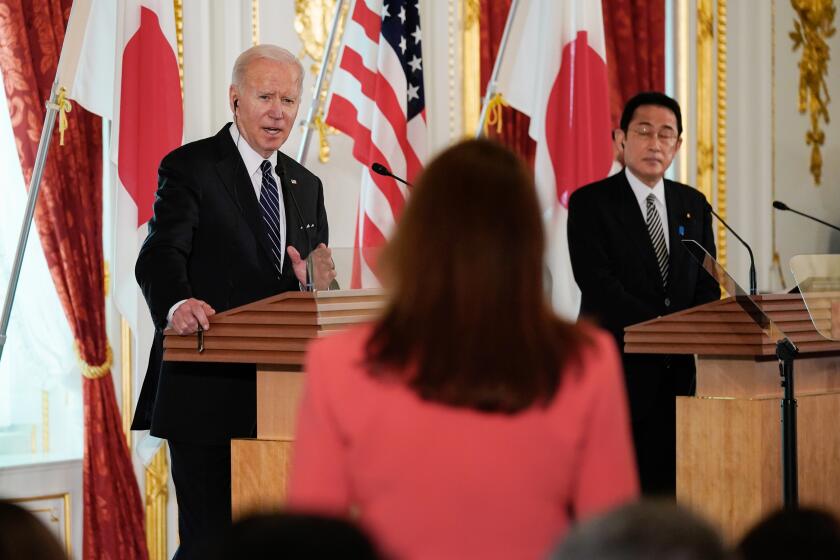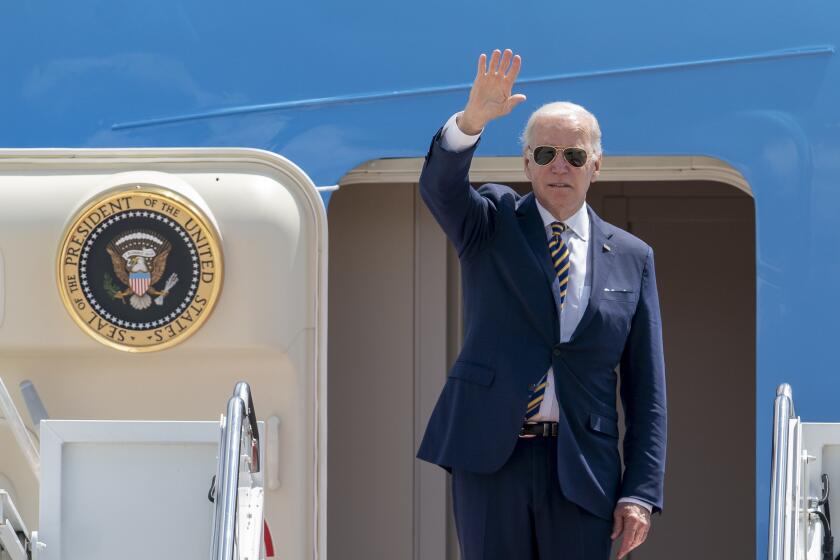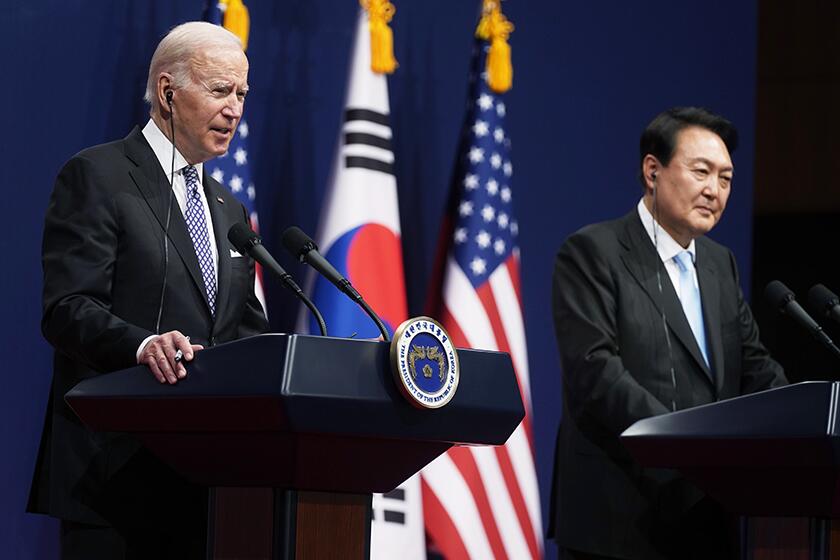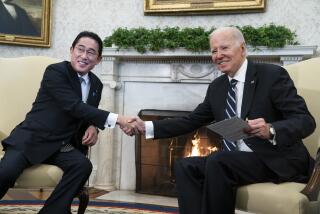Biden unveils a U.S.-Asia trade initiative that falls short of a free-trade deal
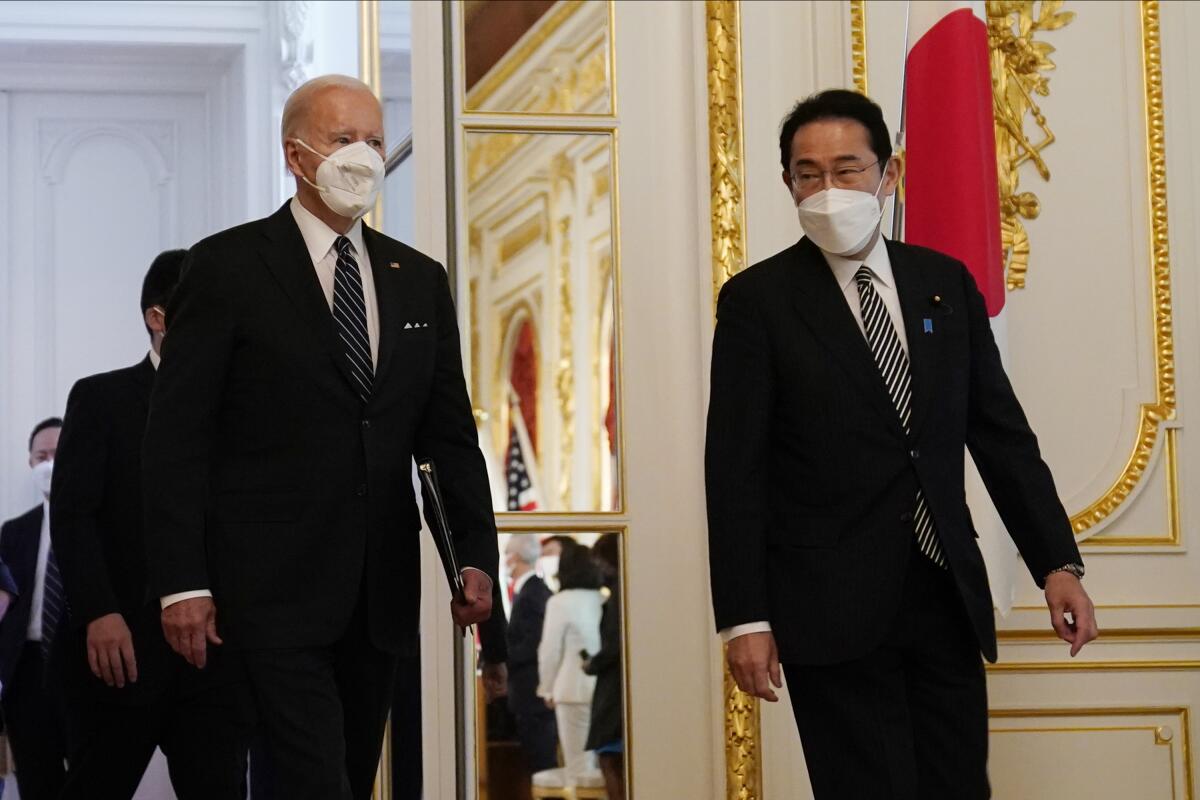
- Share via
TOKYO — President Biden on Monday unveiled an initiative that he said would bind the U.S. and Asian economies more closely but that falls short of a free-trade agreement and remains vague on details.
The newly named group, the Indo-Pacific Economic Framework for Prosperity, is intended to increase cooperation on trade, energy, the supply chain and anti-corruption efforts and counter the growing influence of China. Leaders of the framework have yet to flesh out how the goals would be met — and do not even define the effort as a pact — in an open-ended strategy used to lure countries to join and stay in the bloc.
At an official launch event in Tokyo intended to convey unity, Biden, Japanese Prime Minister Fumio Kishida and Indian Prime Minister Narendra Modi were joined by representatives from other member countries who appeared virtually. In a possible sign that the new framework was not drawing enthusiasm, several of the countries did not send their top leader to the announcement.
“We’re writing the new rules for the 21st century economy that are going to help all of our countries’ economies grow faster and fairer,” Biden said.
Leaders throughout the region have been pressing for a traditional free-trade deal that would open American and Asian markets to each other and help Pacific countries compete with China’s economic dominance. But the Pacific trade pact negotiated by the Obama administration a decade ago is politically toxic in the U.S., excoriated by the labor movement on the left and abandoned by former President Trump after he campaigned against it in 2016.
Kishida praised the new framework as a positive sign that the U.S. was engaging in the region but made clear that it did not go far enough during a news conference with Biden earlier in the day.
The president’s statement represents a potential shift in policy that drew an immediate rebuke from Beijing.
“Our position remains unchanged,” he said. “We think it’s desirable for the United States to return” to the Obama-era trade deal known as the Trans-Pacific Partnership.
Singaporean Prime Minister Lee Hsien Loong expressed a similar sentiment, saying the new initiative could be “a valuable platform for the United States to engage in economic diplomacy in the region” while adding that he is hoping for “more ambitious” collaboration in the future.
Muhammad Lutfi, Indonesia’s trade minister, cautioned that the group should not merely be used to contain other countries, a likely reference to China.
There are no binding requirements for the countries in the group at this point and no expectation that any aspect of the still-unwritten plan will need congressional approval in the United States. A two-page fact-sheet included some aspirational language but no details.
When President Biden meets \ with leaders from Asia and Australia, he will face a slew of challenges tied to the war being waged by the Kremlin.
Still, the White House is promoting it as the main economic accomplishment of Biden’s trip to Seoul and Tokyo. Administration officials promise, for example, that the group of countries will eventually be able to prevent supply-chain problems by communicating better and that it will draft rules to better regulate and integrate technology.
But without anything written or agreed to, that remains a hope more than a promise.
Commerce Secretary Gina Raimondo told reporters that this is “the beginning — to begin and get to work and discuss the next steps ahead as we negotiate the specific terms and develop the details of this framework and establishing a new approach to regional economic engagement.”
Jake Sullivan, the president’s national security advisor, said the fact that the new framework is not a traditional trade deal is a feature, not a bug.
Biden on Saturday said that any meeting with North Korean leader Kim Jong Un would “depend on whether he was sincere and whether he was serious.”
“There are free-trade traditionalists who have raised questions about it,” he said. “Our fundamental view is that the new landscape and the new challenges we face need a new approach.”
Katherine Tai, the top U.S. trade representative, acknowledged that the main reason the U.S. is not rejoining the Obama-era trade deal is political.
“The biggest problem is that we did not have the support at home to get it through” Congress, she said. “There’s a very, very strong lesson there.”
The lesson, she said, was that the old deal was “quite fragile” because the U.S. could not deliver on its promises, which included lowering tariffs on imports, and that its collapse helped inform the current thinking in trying to create a deal that goes beyond trade alone.
Officials argue that a lack of consistency in rules and regulations has become as big a trade barrier as tariffs, and that the new framework would address that problem.
In addition to the U.S., the 12 countries that have signed on so far are Australia, Brunei, India, Indonesia, Japan, Malaysia, New Zealand, the Philippines, Singapore, South Korea, Thailand and Vietnam.
“Let’s see where these negotiations take us,” Tai said.
More to Read
Get the L.A. Times Politics newsletter
Deeply reported insights into legislation, politics and policy from Sacramento, Washington and beyond. In your inbox three times per week.
You may occasionally receive promotional content from the Los Angeles Times.

